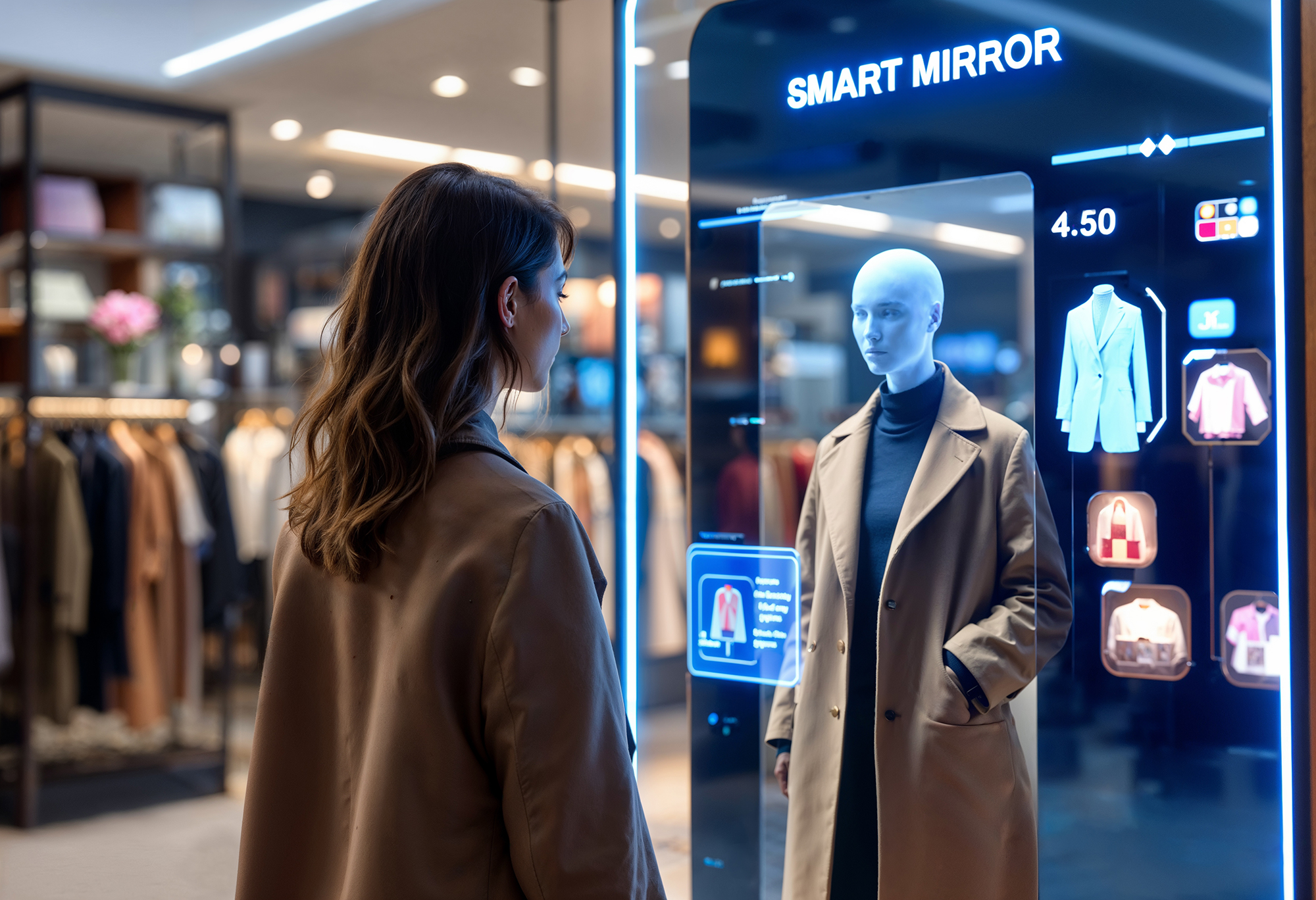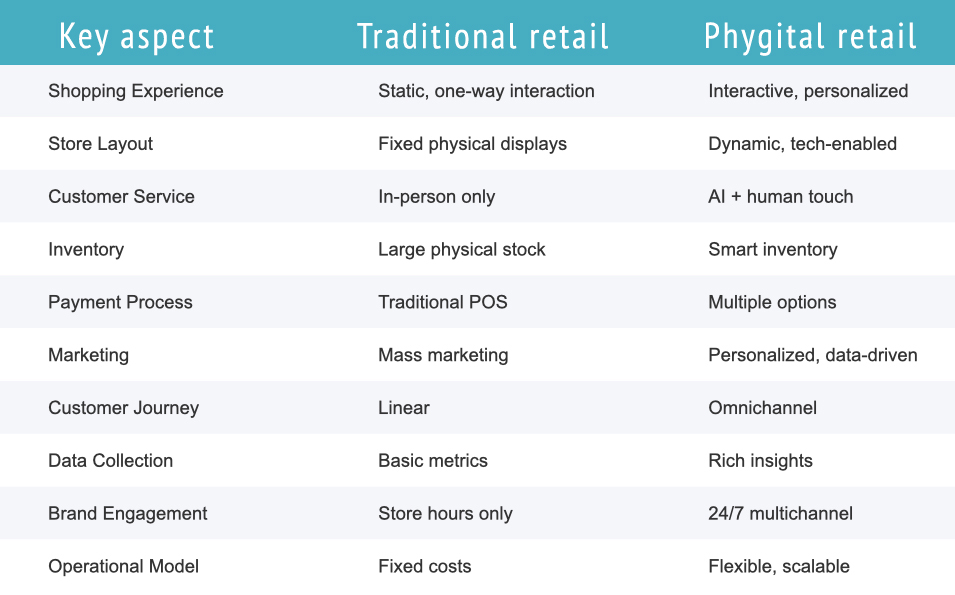
How Phygital is Reshaping the Retail Experience
Picture this: you step into a store and pause at a mirror. “Based on the blazer you bought last month,” it suggests, “this silk blouse would complete your power suit look.” Across the aisle, a couple points their smartphone at a leather sectional, watching in real-time as it virtually appears in their living room, perfectly sized and positioned. Just yesterday, these scenarios might have seemed like scenes from a sci-fi film. Today, they’re playing out in retail stores from Manhattan to Milan. Welcome to the age of “phygital” retail, where the physical and digital worlds converge to transform the way we shop.
While online shopping continues to grow exponentially, with e-commerce sales hitting record highs, something unexpected is happening: customers aren’t abandoning brick-and-mortar stores. Instead, they’re demanding something more powerful – an integrated experience that combines the convenience of digital technology with the irreplaceable aspects of in-person shopping.
The augmented reality (AR) retail market, a key technology enabling this transformation, is set to hit $62 billion by 2029. Nearly 8 out of 10 consumers now express interest in using AR to preview products before purchase, signaling a significant shift in shopping preferences.
What makes this shift particularly noteworthy is its timing, coming as retailers face mounting pressure to innovate or risk obsolescence. The success of early adopters suggests that phygital retail isn’t just a temporary adaptation but rather a glimpse into the future of shopping itself – a future where the boundaries between online and offline commerce disappear entirely.
Redefining retail, one experience at a time
The future of retail isn’t choosing between online or in-store shopping – it’s both.
Phygital enhances physical stores while connecting them to online shopping, giving customers a seamless, personalized experience that moves effortlessly between digital and real-world environments.
This retail evolution reflects a simple truth: modern consumers don’t separate their shopping into neat “online” and “offline” categories. Instead, they move between their smartphones and physical stores, expecting retailers to keep up with their journey every step of the way.
Mobile technology stands at the forefront of this transformation. Payment apps, digital loyalty programs, and mobile ordering systems are increasingly becoming standard features of the shopping experience, rather than novel additions. These tools serve as bridges between the digital and physical worlds, creating a continuous shopping experience that follows customers wherever they go.
Despite the pandemic-induced shift to online shopping, direct-to-consumer (DTC) brands like Casper, Glossier, Allbirds, and Warby Parker have opened physical stores, showcasing the enduring strength of physical retail.
Rather than closing their doors, major retailers are reimagining their physical spaces, incorporating digital touchpoints throughout the shopping journey. Interactive displays, smart mirrors, and augmented reality tools are becoming commonplace, allowing customers to access detailed product information, customize items, and visualize their potential purchases in real time.
This hybrid approach offers unprecedented flexibility. Shoppers can research products online, customize their selections, and choose whether to complete their purchase in-store or have items delivered to their homes. The result is a shopping experience that adapts to individual preferences rather than forcing customers into predetermined paths.
Key technologies
The Retail Technology Show 2024 recently showcased several tech trends that are blurring the line between online and in-store shopping.
Mobile technology is now central to modern retail, with over half of Americans using digital wallets and 81% researching online before making a purchase. Retailers are capitalizing on this shift by developing sophisticated store apps that combine navigation, product information, and personalized promotions. These apps are increasingly central to loyalty programs, delivering mobile coupons and enabling seamless ordering.
IoT (Internet of Things) technology is transforming retail through various innovations that streamline operations and enhance customer experience. Smart shelves with sensors monitor inventory levels and product placement, while RFID-enabled smart tags (Radio Frequency Identification), track product movement and prevent theft. The technology enables self-checkout systems and smart shopping carts, facilitating independent purchases.
IoT also powers interactive experiences through NFC and RFID, allowing customers to access product information instantly via their phones. Beyond the store floor, IoT drives retail analytics for optimizing store layouts and operations, powers digital signage for advertising, and enables personalized customer experiences through data analysis.
Augmented reality (AR) and virtual reality (VR) technologies enable immersive, omnichannel shopping experiences that allow consumers to engage in virtual activities. Many major brands, such as Burberry and L’Oréal have already incorporated virtual try-on features into their online platforms, transforming the e-commerce experience.
Fashion brands like Tommy Hilfiger have created AR-powered virtual catwalks to elevate runway commerce and deliver personalized, immersive shopping experiences. This allows consumers to explore curated, immediately shoppable fashion looks in a customized, interactive environment.
Additionally, these campaigns create memorable, shareable experiences that increase brand recognition. At Viva Technology 2024 in Paris, RIMOWA used Apple’s VR, Vision Pro, to let attendees virtually explore their suitcases, showcasing design and features interactively. This innovative approach created a memorable experience and highlighted the brand’s focus on innovation in ways that traditional marketing methods cannot match.
QR codes are enjoying a resurgence in retail, with brands like Ralph Lauren embedding digital tags in clothing to provide authentication and styling guidance. These interactive QR codes allow customers to access product information, recommendations, and other digital content directly from the physical garment, blending the online and in-store experience.
Engaging shoppers, empowering retailers
Embracing phygital customer experiences can deliver a range of powerful benefits for businesses:
– Enhanced customer engagement: phygital experiences integrate digital and physical touchpoints seamlessly, allowing brands to create tailored journeys that align with customer preferences across channels.
– Personalized experiences: augmented reality, AI, and customer data enable highly personalized, immersive phygital experiences that resonate on a deeper level.
– Richer customer insights: phygital provides an additional layer of valuable customer data, empowering retailers to better understand interests, behaviors, and shopping trends.
– Strengthened brand loyalty: by blending the physical and digital, phygital experiences cultivate unique, memorable connections that foster stronger customer-brand relationships and loyalty.
– Increased sales: positive phygital experiences not only drive repeat business, but also powerful word-of-mouth that can significantly boost sales through trusted personal recommendations.
The benefits of this phygital approach go even further, reducing the need for large in-store inventories through AR customization and lowering returns by up to 25%.

The road to phygital
The implementation of phygital retail strategies presents both significant opportunities and complex challenges for retailers. While the potential benefits are substantial, businesses face considerable hurdles, starting with the high upfront costs of technology infrastructure, staff training, and the creation of high-quality immersive content.
The complexity deepens with the technical challenges of integrating new technologies with existing systems, ensuring seamless data flow across channels, and maintaining device compatibility – tasks that demand specialized expertise and ongoing maintenance.
Privacy and security concerns loom large as retailers collect more customer data, making it imperative to balance personalization with data protection. Retailers must adopt robust data encryption, ensure compliance with privacy regulations like GDPR, and be transparent about data usage. Empowering customers with control over their data (such as clear opt-in mechanisms) can foster trust, while still allowing brands to deliver tailored experiences that enhance shopping engagement.
Additionally, retailers must carefully navigate the delicate balance between technological innovation and maintaining the human touch that many customers still value, as over-reliance on technology risks alienating traditional shoppers.
The adoption of advanced technologies like AR/VR faces further obstacles due to expensive devices and the learning curve required for both consumers and employees.
To overcome these challenges and capitalize on the opportunities ahead, retailers must focus on these key strategies:
– Data integration: leveraging customer data across channels for personalized experiences and accurate product information.
– Seamless checkout: ensuring frictionless transitions between online and in-store, with features like mobile payments and hybrid purchase options.
– Consistent branding: maintaining a unified brand image across digital and physical platforms to build trust and loyalty.
Phygital’s prospects
Looking ahead, the phygital retail sector is poised for continued growth, particularly in the luxury segment. Brands such as Louis Vuitton are turning ready-to-wear items into digital ‘’collectible’’ NFTs (Non-fungible tokens), reflecting a growing trend where luxury brands are keenly adopting blockchain technology to combine physical items with digital technology.
As legal frameworks evolve to match technological advances, success in this new retail landscape lies in finding a new way to engage with consumers and offer exclusivity in an increasingly digital world.
The future promises more sophisticated personalization, predictive analytics for inventory and staffing decisions, and innovative solutions to bridge the physical-digital divide, all enhanced by the emergence of 5G technology and advances in biometrics and payment systems.
The key to success will be maintaining a steadfast focus on creating memorable brand experiences while thoughtfully implementing new technologies.

